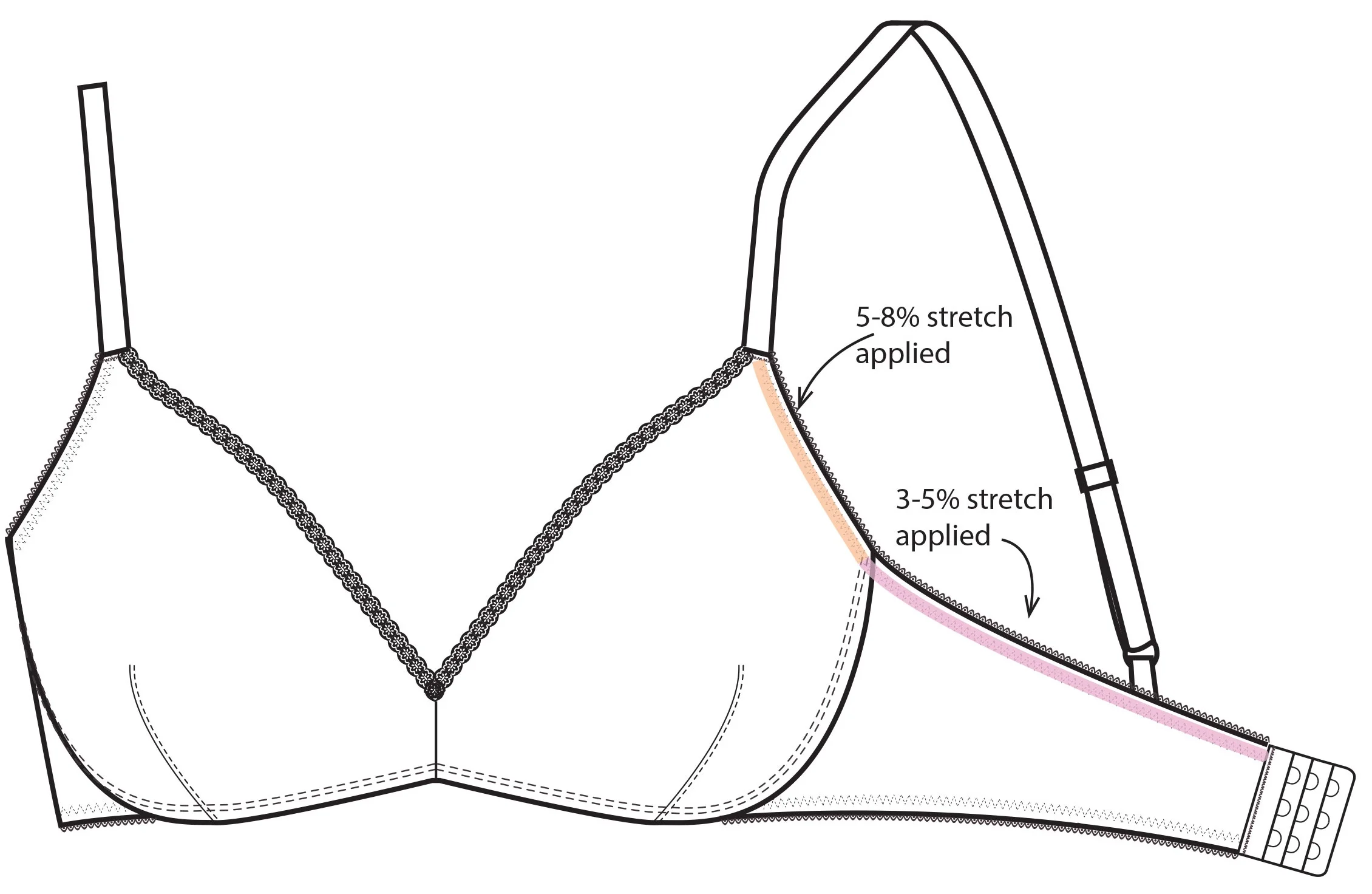What tension to sew elastic onto bras and briefs
When you begin design your own lingerie, and want to know how to sew underwear it can be hard to know where to start, with what tension to put on your elastic to sew your brief or bra. Because if you don’t get the tension right (ish) to start with when it comes to fit how will you know if you’re fitting to the pattern of your bra or the fit of your elastic.
For example when you make your own lingerie, if the brief digs in at the waist do you loosen the elastic or add more into the pattern?
When sewing elastic I now go on the feel of the elastic and from this to make every piece consistent I have marked my sewing machine with lines, to where to pull the elastic, so no matter how many pieces I make each leg will measure the same. On the same style, the same amount of elastic tension should be used whether your bra size is a 32C or 32F.
What type of elastic to use
The manufacturers do lots of testing on elastics to ensure you use the right type for the right area, generally a bra uses a brushed back elastic, and the firmer and wider it is the more support and control it will have. Briefs can have brushed back elastic, but I wouldn’t use such a heavy elastic or as wide, a softer more delicate elastic is usually used on the brief. This is because the bra will tend to have a heavier fabric, so a heavier elastic can be used.
Each type of elastic has elastic fatigue, which means that it can be only stretched to a certain point. The more you stretch the elastic and sew then the more stitches you are putting onto a smaller space of the elastic and with lighter weight elastic, this causes the elastic to go wavy on the rebound. (I wrote more in depth about this on sewing fold over elastic)
How much to pull the elastic
So you’re ready to sew and to make your own lingerie, so how much do you stretch the elastic for your lingerie? Generally elastic works best when stretched 3-8%, with 8% only being used on the smaller parts of the garment as it’s a bit extreme, as remember the more you stretch the elastic the more stitches you are putting on that space of elastic.
As a general rule when making a new brief I put more stretch on the elastic, than say the under-band of the bra.
The underarm/top of the wing I usually put the same amount of stretch as the under-band, tightening up over the underarm as this is an area which tends to flip out, and you want that part to contain your breast, not to have the squishy underarm arm that can occur.
On the neckline of the bra I don’t stretch the elastic that much as I don’t want it to dig into the breast.
All this is done very intuitively, and as stated I have done trial and error with how much to stretch the elastic to and have marked my sewing machine where I pull the elastic to, to ensure every garment is the same. My advice would be get a bra you already own and stretch the under-band to see how much it stretches by. By doing this again and again you get to know the feel of how the elastic and how it should be applied.
If you’re working with non stretch fabrics on your briefs then you will need to stretch the elastic further than stretch fabrics, as you need to give the fabric it’s ability to fit over you hips but then come back to it’s shape when being worn.
Also if you have a full brief, style brief you will be stretching the elastic slightly more (so to enclose your bottom) than if you were sewing a Brazilian style brief which falls over the fullest part of the bottom, so less tension to the elastic would be applied so not to dig in.
If you’re still unsure and like to be led by mathematics then another way is to measure what say the brief waist is measuring and reduce it by 5%, cut the elastic by that measurement, sew it so it forms a loop then pin it at the half and quarter to ensure equal tension around the whole garment. And then go from there, adjusting accordingly. So if your waist finishes at 29cm on the half you would cut the elastic to 57cm. (29x2= 58cm to get whole of waist measurement. 58+2cm = 60cm you’re adding 2cm to overlap the elastic and sew together to form the loop. 60-5% =57cm, so if you sew then your would reach 28.5cm which is 5mm in tolerance to the waist measurement, or if you’re wanting to get it exact then you need to reduce your seam allowance on the elastic - basically this exercise is to get you to feel the tension of the elastic applied rather than exactly work it out).
To learn more about Lingerie components:


